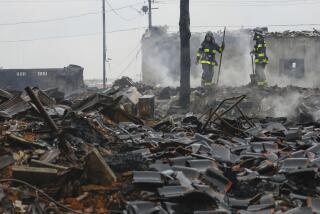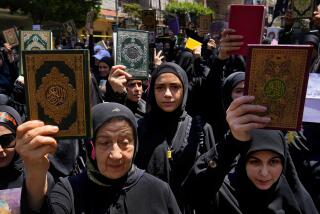Europe Struggles to Cope With Tsunami’s Toll
- Share via
STOCKHOLM — Their creamy-white complexions pinkened by the sun, blond hair matted by seawater, the parade of wounded moved through Sweden’s main airport Thursday evening. They staggered into the frigid temperatures wearing the flip-flops and tube tops of a beach paradise.
Four days after gigantic waves swatted people from the shores of nearly a dozen countries, it has become clear that hundreds and perhaps thousands of Swedes, Norwegians, Germans, Italians and other Europeans were among those killed. Their respite from dark, cold winters, in southern Asia’s luscious warm climes, ending in horror.
Sweden may be harder hit than any other European country, with 44 reported killed and authorities here Thursday raising the number of missing nationals from 1,500 to 2,500.
“In the worst case, the number [of fatalities] could rise over 1,000,” Swedish Prime Minister Goran Persson said. “Sweden is a small country, and it is a huge number of dead.”
The number of European victims is but a fraction of the Asians killed. Yet seemingly every Swede knew someone, or knows someone who knew someone, who was killed or injured in the catastrophe.
From royalty and political leaders to the workaday citizen, Europeans on Thursday mourned their growing number of dead. And in some quarters, sorrow turned to anger at governments for what many saw as a sluggish rescue response.
“The Swedish government reacted way too slow; it just took too long,” said Lena Edstrom, a mother of two whose good friend survived the tsunami but lost a daughter. “And the government down there [in Thailand], they could have warned the people.”
Edstrom, her eyes as red as her winter coat, spoke as she lighted candles after an emotional memorial service at Stockholm’s cathedral attended by King Carl XVI Gustaf, Queen Silvia and top ruling and opposition politicians.
“The government made blunder after blunder [and] the people’s verdict could be harsh,” the leading Aftonbladet newspaper said in an editorial. The paper has been publishing row upon row of photographs of dead and missing Swedes.
The newspaper Expressen said it had received more than 1,000 e-mails and telephone calls from readers expressing anger and disappointment.
Responding to the criticism, Prime Minister Persson said in a news conference Thursday that his government’s actions were on par with those of Sweden’s neighbors. But, he said, “people who are affected are entitled to criticize us; it is deeply human and understandable.
“There is nothing worse than losing one of our closest friends.”
New Year’s celebrations have been all but eliminated in Sweden, with a semi-official state of mourning declared and flags to be flown at half-staff. Authorities have dispatched teams to Thailand and Sri Lanka to take DNA samples to help identify the dead. Cellular telephone companies have eliminated fees for calls to the shattered region.
At Stockholm’s main international airport, authorities have set up a crisis center where relatives come with the faint hope of locating their missing loved ones. Some lucky ones have made contact and know to expect a battered but surviving relative. Others have had no word.
Escorts in bright yellow vests take them, one by one, into an inner sanctum where they can wait for arriving flights. Priests, counselors and doctors are on hand for them and for survivors.
“These are broken families,” said Elizabeth Lewander, a social worker.
Some children arrive from Asia catatonic, without their parents. Other arrivals include adults who have lost their partners.
And these are the people well enough to travel, Lewander noted; the psychological trauma will only worsen as the more severely injured are brought home in specially fitted airplanes, and recovered bodies are flown in.
“We are not used to this in Sweden,” she said. “We have been so far removed from war and catastrophes. But now everyone knows someone, if not their relative, then someone at work or school or a neighbor, who has been affected.”
Until now, the worst disaster for Swedes in recent history was the sinking of a passenger ferry en route to Estonia 10 years ago in September. Of 852 people who drowned, 551 were Swedes. Then, as now, death was a watery nightmare, and hundreds of bodies were never recovered.
Up to 30,000 Swedes were vacationing in the region when the killer waves hit. Most were in Thailand, such a popular destination for Scandinavians that bars and nightclubs in Stockholm have Thai names, feature Thai themes and specialize in Thai beer.
Looking over Stockholm’s late-December skyline, it is easy to see the allure of places such as Thailand and Sri Lanka, whose white beaches, spectacular coral reefs and endless sunshine are antidotes to northern Europe’s dark, damp winters. Car headlights are on by 3 in the afternoon, and it has been snowing so much in recent days that white mini-dunes line the roadway and icy stalactites hang from highway overpasses.
It has become an annual ritual of sorts for Europeans, of varying economic means, to seek out dream vacations in Asian tropics. After Sweden, Germany has the highest number of missing tourists, about 1,000, followed by Italy, with 700, and Norway, with 430.
German Chancellor Gerhard Schroeder said “hundreds” of his fellow citizens probably perished. In Thailand alone, 2,230 foreigners have officially been reported dead.
The estimated 10,000 British tourists in the area at Christmas ranged from up-market customized vacationers to students seeking adventure in their “gap year” between high school and college. The dead include a volunteer wildlife conservationist and relatives of film director Richard Attenborough; among the survivors are an earl, backpackers and numerous young honeymooners.
Throughout Europe, where TV coverage of the disaster has been nonstop, relatives and friends have also turned to Internet bulletin boards in a frantic search for information about the missing. Scores of people have posted queries.
“Am desperately trying to get any information on whereabouts of my sister and her family,” writes Iain Scott Rae of Scotland.
Swedes did mark one happy ending, of sorts. An 18-month-old Swedish toddler, found wandering alone by a road in Phuket, Thailand, his face scratched and bitten by bugs, was reunited with his wounded, hospitalized father. “Pappa!” headlines screamed in Swedish newspapers Thursday.
The reunion occurred after a picture of the boy, Hannes Bergstroem, was posted on the Internet by hospital staff and recognized by an uncle.
But his mother, Suzanne Bergstroem, is still missing.
A Thai princess reportedly had flown Hannes, after he was first found, by helicopter to a hospital for treatment.
The princess who saved the boy “also saved my soul,” the sobbing father, Marko Karkkainen, said from his hospital bed. “I couldn’t have survived if I had lost them both.”
Janet Stobart in The Times’ London Bureau contributed to this report.
*
(BEGIN TEXT OF INFOBOX)
Foreign victims
More than 6,000 foreign tourists, mostly Europeans, are missing after Sunday’s earthquake and tsunami in southern Asia. Here is a tally, in order of the number killed as reported by each country’s foreign ministry:
*--* Country Dead Missing Sweden 44 2,500 Germany 33 1,000 Britain 28 France 22 96 Norway 21 430 Italy 14 700 Finland 14 263 Switzerland 12 - United States 14 - Australia 9 9 Japan 9 - South Korea 8 8 Denmark 7 24 Singapore 7 227 Netherlands 5 - Austria 5 16 Belgium 5 274 Poland 4 43 South Africa 4 16 Canada 3 13 Brazil 2 - Russia 1 - Taiwan 1 - New Zealand 1 279 Croatia 1 9 Malta 1 - Czech Republic - 100 Turkey - 53 Ireland - 20 Israel - 12 Iceland - 11 Luxembourg - 11 Spain - 11 Greece - 9 Portugal - 8 China - 7 Mexico - 4 Total 273 6,186
*--*
Notes: Some countries that were struck by the tsunami have listed foreign visitors as dead or missing but their home countries have not yet done so. In addition, some nations, including Denmark and Russia, have said they have not been able to make contact with some citizens but have not yet listed those people as dead or missing.
Sources: Reuters
Los Angeles Times
More to Read
Sign up for Essential California
The most important California stories and recommendations in your inbox every morning.
You may occasionally receive promotional content from the Los Angeles Times.











